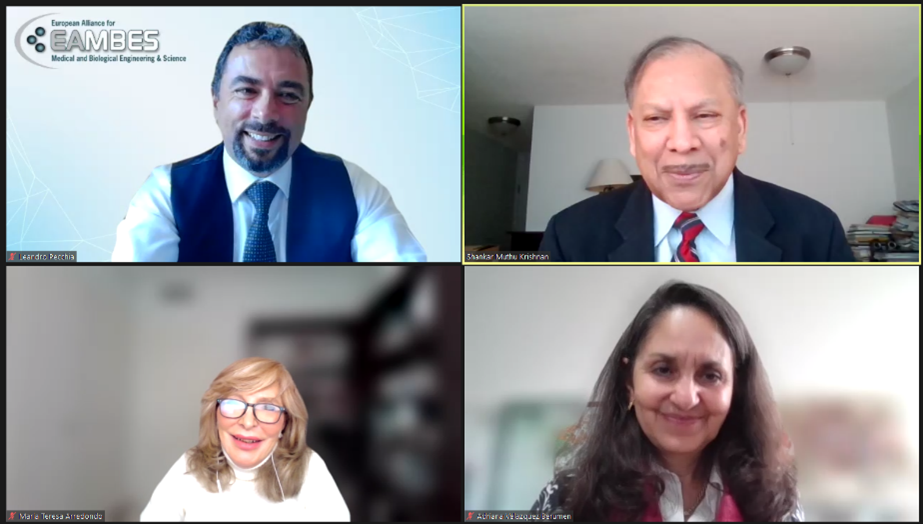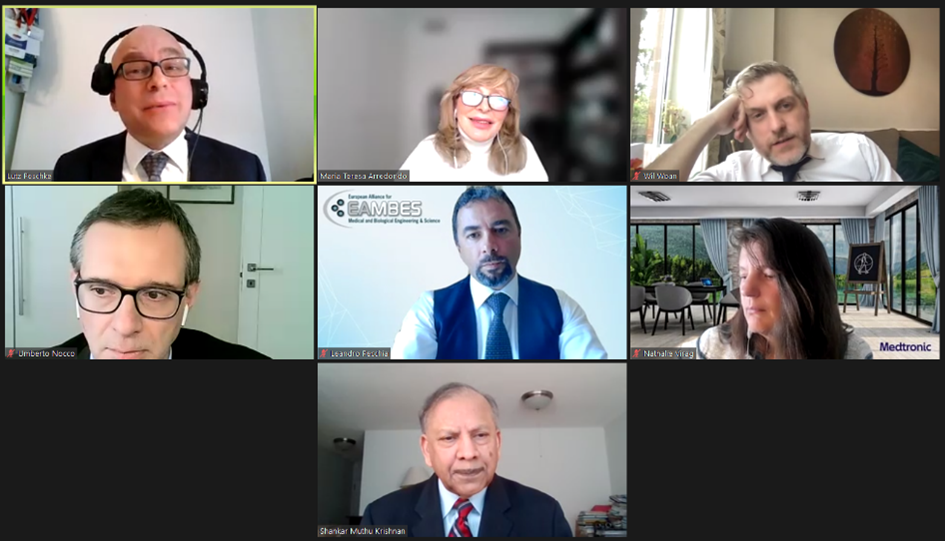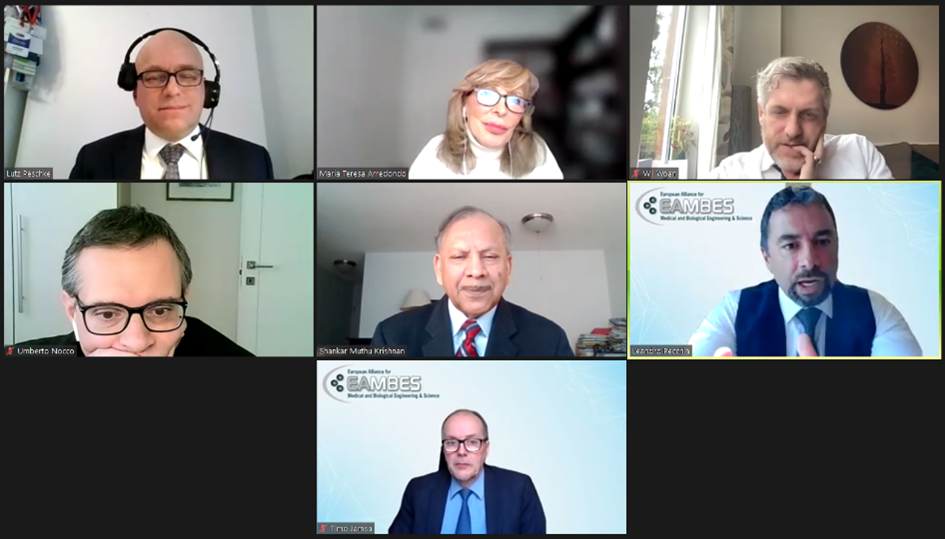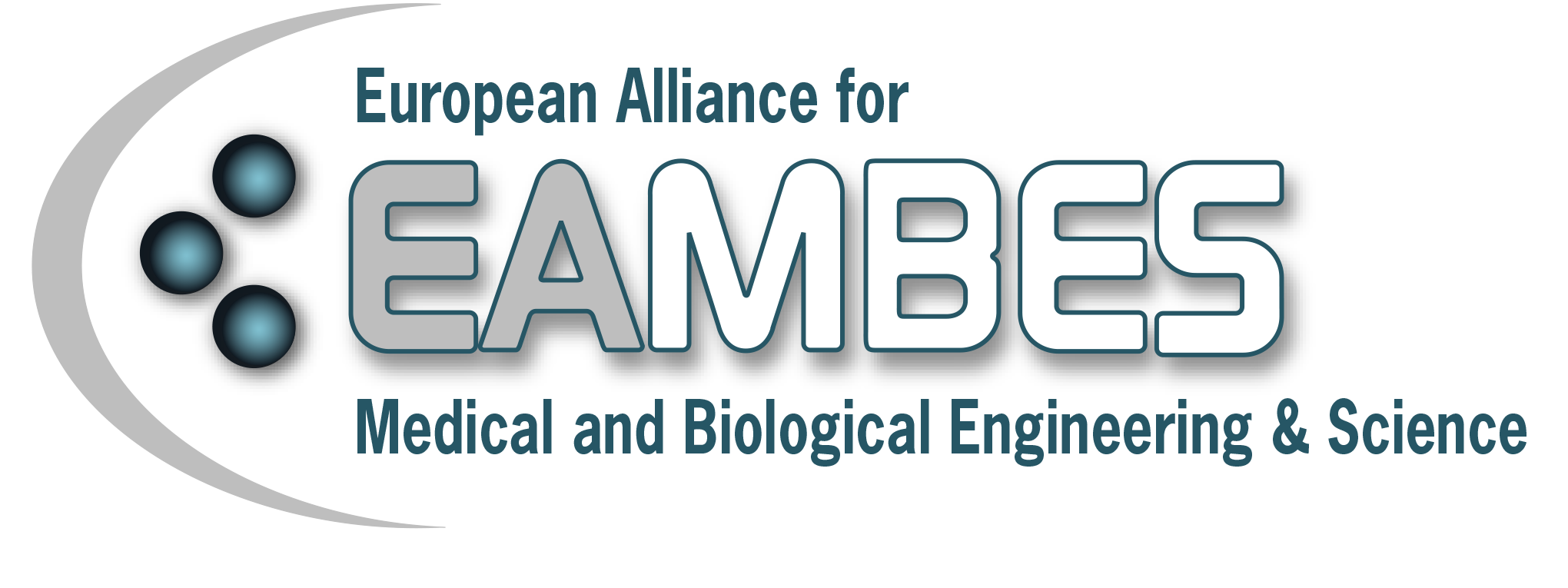The third EPIG meeting


If you missed EAMBES March 29 webinar on Practices, Impact and Promises of Biomedical Engineering for advancing the EU’s Health Priorities, we invite you to access the recording at EAMBES YouTube channel:
Playlist with panellists: https://www.youtube.com/playlist?list=PLGHqtFpFzTwcO-XHDsrptYoWBg52JGmHP
Full recording: https://www.youtube.com/watch?v=XMx6ewrmxRQ
Executive Summary
The online event entitled “Practices, impact and promises of Biomedical Engineering for advancing the EU’s health priorities”, hosted by Member of the European Parliament (MEP) Tomislav Sokol (EPP, Croatia and organized in collaboration with the European Alliance for Medical and Biological Engineering (EAMBES) took place on 29th March 2022.
The event was opened by MEP Tomislav Sokol (EPP, Croatia) who highlighted the importance of the event as a means to focus the EU’s attention on healthcare innovation and research and those who bring it about, as well as by Prof Leandro Pecchia, the incumbent president of EAMBES, who highlighted the growth of biomedical engineering in the past few years both in terms of impact and in terms of importance.
The speaker panel consisted of the following representatives:
- Prof Timo Jämsä, former president of EAMBES
- Dr Adriana Velazquez Berumen, Group Lead on medical devices and in vitro diagnostics at the World Health Organization,
The Q&A and discussion featured the following speakers:
- Maria Teresa Arredondo, Professor at the Bioengineering and Photonics Department of the Universidad Politécnica de Madrid
- Dr Nathalie Virag, specialist in the fields of cardiovascular disease and computer modelling
- Wil Woan, chair of Heart Valve Voice
- Dr Umberto Nocco, President of the Italian Association of Clinical Engineering
- Prof Lutz Peschke, Assistant Professor at the Department of Communications and Design at Bilkent University, Ankara
- Dr April Baller, Emergency Programme Lead at the World Health Organisation
To set the scene for the event, Prof Timo Jämsä, former president of EAMBES, gave an overview of the organisation’s activities and the role of biomedical engineering in advancing healthcare and providing solutions to patients. Dr Adriana Velazquez Berumen then took the floor, stressing the urgent need for a standardized international nomenclature for medical devices – something that would allow for improved access to health technologies and would give researchers and innovators better tools to accomplish their goals.
The panel discussion and Q&A were jointly moderated by Prof Pecchia and by Prof Shankar Krishnan, chair of the International Federation of Medical and Biological Engineering (IFMBE). The moderators first introduced Prof Maria Teresa Arredondo, who gave a presentation on how biomedical engineering can have a profound impact on building the healthcare systems of tomorrow – and how intertwining data and artificial intelligence with health can produce better and faster results for patients.
Dr Nathalie Virag echoed the statements made by Prof Arredondo, underlining the importance of data and how it allows for a more holistic approach to healthcare, namely one that focuses on patients and their needs, as well as on outcomes.
Wil Woan gave the patient perspective of the impact that biomedical engineering, with a highlight on the experiences of cardiovascular diseases. He highlighted how the increased use of technology and devices has given patients a better grasp on managing their own health and how this, combined with more innovation and a better policy framework could create a truly patient-centred healthcare system.
Dr Umberto Nocco pointed to the need for more cooperation between researchers and healthcare managers in order to improve and increase the use of new advanced technologies. According to Dr Nocco, the pandemic brought along with it severe difficulties in certain areas of implementing new solutions in to existing workstreams, but also underlined the need for more joint work between stakeholders.
Prof Lutz Peschke went into detail about the importance of proper communication especially during crises. He pointed to the need for citizens and patients to be more invested in the work of researchers and policymakers, as that would reduce the risks of disinformation and would also improve the understanding of experts for the needs and experiences of ordinary people. Finally, he highlighted that this can be accomplished mainly through the ethical use of health data which is quickly becoming an integral part of any type of healthcare research.
Finally, Dr April Baller was given a floor to present her reflections on the impact of COVID-19 in terms of crisis-preparedness and possible future solutions. She echoed statements made by previous speakers on the importance of cooperation – not only between policymakers and other members of society, but also between countries and international organisations. She also highlighted the efforts currently underway at the WHO to create a more robust research and innovation sphere which is meant to give a better understanding of key development priorities that would ultimately strengthen the world’s response to the next pandemic.
In his concluding remarks, Prof Pecchia thanked MEP Sokol, the speakers and panellists and the attendees for their contributions. He ultimately highlighted the achievements of biomedical engineers over the last few years and more specifically those of EAMBES and its members in achieving better recognition for the profession and its benefits.
Welcome & Introduction

Tomislav Sokol MEP, the event’s host, began his introduction by highlighting the fact that healthcare has never been too far up the EU’s agenda mostly due to its lack of competences in the field – but that changed with the onset of the COVID-19 pandemic and the shift in political priorities related to Europe’s Beating Cancer Plan. Together these changes have propelled health to the very top of the EU’s health priorities.
When it comes to specifics, MEP Sokol highlighted several areas that are getting the most attention by the EU – namely crisis preparedness, early response to pandemic situations, cancer, equality of access to healthcare and Europe’s autonomy vis-à-vis medicinal products and devices, which is dangerous in special situations such as war, pandemics, etc. European Union has the regulatory and financial possibilities to influence member state sections in the area of healthcare to achieve better health outcomes.
According to MEP Sokol, biomedical engineering and research and innovation have a key role to play in tackling the healthcare issues of tomorrow. Thus, there is a need for the EU to create an atmosphere that fosters research and innovation, and this is something that has already been recognized but also requires significant additional support. MEP Sokol pointed to the adoption of the Medical Devices Regulation and the regulation on Health Technology Assessment as crucial, yet insufficient regulatory measures meant to provide researchers with the tools they need to keep Europe ahead of the curve.
Another key pillar for researchers according to MEP Sokol is the EU’s financial framework which allows researchers to pursue innovation. Among the most important tools at the EU’s disposal in this field are Horizon Europe, the EU4Health Programme and Cohesion Policy. All three of these have seen an increase in terms of funding allocated for healthcare and innovation in the field of healthcare and are key to allowing Europe to keep its competitive edge.
In conclusion, MEP Sokol underlined the importance of the event as a way to focus the EU’s attention on researchers and innovators who are ultimately the ones ultimately for bringing better outcomes and results to Europe’s patients and citizens.
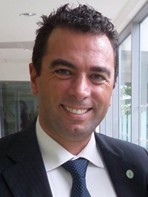
Prof Leandro Pecchia, president of EAMBES, thanked MEP Sokol for his opening remarks and went on to highlight the evolution that biomedical engineering has undergone in the past few centuries. He highlighted the fact that while doctors and patients have always been present in the field of healthcare, it is the environments they operate in that have changed to improve quality of life– and that is where biomedical engineering comes into the picture.
To illustrate the growth in the field of biomedical engineering, Prof Pecchia pointed to the ever-rising tidal wave of patents being registered both in the EU and across the world for new devices. He further reiterated that this contribution has been grasped by international organisations like the WHO which has highlighted the need for more biomedical engineers to be trained in order to innovate and service the increasing number of new devices being delivered to patients.
In conclusion, Prof Pecchia gave an overview of the evolution of medical devices over the last few hundred years and pointed to the fact that there are still areas in which Europe can do better – such as in the case of Personal Protective Equipment (PPE), which has barely evolved since the 1300s while its production chain has left Europe entirely dependent on third countries. He made an appeal for the money that is already being invested in research and innovation to be spent responsibly and to follow the needs of patients and citizens.
1. Setting the scene
- Biomedical Engineering – Practices, Impact and Promises
Prof Timo Jämsä, former president of EAMBES, gave an overview of the organisation. He pointed to the EAMBES’ place in the world of healthcare and its relation to other global organisations including the WHO and the International Federation of Medical and Biological Engineering (IFMBE). He further highlighted the main priorities that the organisation aims to address in its collaboration with EU stakeholders, including the European Health Data Space, support for the EU’s medical device manufacturers and for its researchers and innovators.
Prof Jämsä underlined the importance of the work of the organisation’s members when it comes to contributing to civil society and services across Europe, especially in the backdrop of the COVID-19 pandemic and pointed to EAMBES’ earlier work with the European Parliament.
In conclusion, Prof Jämsä listed the most important topics that EAMBES sees as crucial for discussion and action in the fields of healthcare and biomedical engineering – namely EU regulations on medical devices, PPE and AI, shifting of attention to the challenges of tomorrow and focusing funding to problem areas that have remained below the radar in the last few decades.
Dr Adriana Velazquez Berumen, Group Lead on medical devices and in vitro diagnostics at the World Health Organization, began her presentation with providing background on the role of medical devices and biomedical engineers in the healthcare landscape.
She further went on to give additional information on the WHO’s “Triple Billion” targets work programme. It features the goal of providing 1 billion more people with universal health coverage, 1 billion more people with better health and well-being and most topically – 1 billion more people with better protection from health emergencies – and area in which biomedical engineering plays a crucial role.
Dr Velazquez Berumen highlighted the speed with which the WHO worked at the start of the pandemic to provide technical specifications and additional guidance on PPE which was meant to create a unified baseline for their production. She also underlined the importance of the WHO’s efforts in ensuring access to technologies in low-resource settings as well as its approach to forging an international standardized nomenclature – something that requires not only policymakers’ input but also the knowledge and understanding provided by researchers and experts.
Finally, Dr Velazquez Berumen stressed the vital need for biomedical engineers to be included and recognised as members of the regular healthcare work force. According to her, their expertise and drive to improve outcomes for patients and citizens will be crucial for the future as the world gears up for the next crisis.
Prof Shankar Krishnan, chair of IFMBE followed up Dr Velazquez Berumen’s presentation with a question on the lessons that the world can learn from the last couple of years of the COVID-19 pandemic on integrating advanced technologies and new approaches to strengthen its crisis preparedness. In turn, she highlighted the need for all of the most basic and essential tools, such as Personal Protective Equipment and Oxygen to be available everywhere around the globe. She then pointed to the fact that the COVID-19 pandemic also led to a rethink in how people understand treatment of diseases. As regular medicine was insufficient to deal with the pandemic, the role of biomedical engineers, who are precisely the ones developing the tools that saved lives, was recognized.
Prof Pecchia then followed up with a question on the importance of data and implored Dr Velazquez Berumen to highlight how vital it is to the work of researchers. Calling it “absolutely indispensable”, she explained that since the start of the pandemic, the lack of data was among the biggest issues for decisionmakers. Furthermore, understanding where the needs are, how to deal with them, what the costs are for different solutions and whether they even reach their final beneficiaries is essential – and this is still something that is lacking.
2. Discussion and Q&A
Prof Pecchia, along with Prof Shankar Krishnan, chair of IFMBE, co-moderated the discussion and introduced panellists taking part in the Q&A session.
Following a brief introduction, Prof Krishnan gave the word to Maria Teresa Arredondo, Professor at the Bioengineering and Photonics Department of the Universidad Politécnica de Madrid. In her presentation, she highlighted that the world finds itself in a historic moment in which biomedical engineers have the potential to have a profound impact on citizens and their health by incorporating smart technologies into building a healthcare system of the future. According to her, this will require the joint work of experts and all manner of stakeholders, as well as the extensive use of data, artificial intelligence and other technologies to make decisions and streamline the information flow between patients and healthcare workers.
Prof Arredondo further underlined how crucial it is to invest more in digitalisation and technologies in order to provide better results for patients, strengthen healthcare systems and ultimately build a future-proof framework. She concluded with an appeal to the European Parliament to seize the moment and build a stronger, more resilient and innovation friendly policy environment.
Prof Krishnan followed up Prof Arredondo’s presentation with a question on the evolution of telemedicine and the role of biomedical engineers in the field. She highlighted the fact that now that the world has moved onto the use of telemedicine, it is unlikely for it to go back. She explained that the pandemic forced the implementation of many new types of services that safeguard people’s mental and physical health and that their use will only grow in the future.
Prof Pecchia then went on to give the word to Dr Nathalie Virag, a specialist in the fields of cardiovascular disease and computer modelling, asking about the importance of data to research in Europe, as well as to diagnosis and treatment of patients. Dr Virag explained that through the advanced use of data, societies can move onto a more holistic approach to healthcare. Echoing the statements made by Prof Arredondo, she highlighted the fact that the world is slowly inching towards an increase in predication and prevention practices, rather than simply treatment.
Dr Virag pointed to the importance of proper access to different types of data and how the lack of such makes it more difficult for research and innovation to pick up pace. She again pointed to the need for standartisation of data to speed up the development of new therapies and highlighted that it would be important to bring in new stakeholders to achieve this – such as Big Tech and telecommunication processes. In conclusion Dr Virag stressed the importance of putting patients first, which is precisely the reason why more data is needed.
Prof Krishnan then gave the floor to Wil Woan, chair of Heart Valve Voice, who laid out the main concerns for cardiovascular disease patients and gave an overview of their impact on shaping decisions in the field. He first pointed to the fragmentation of the cardiovascular disease policy space across Europe and the need to standardize and synchronize it. More specifically he underlined the lack of proper cardiovascular strategies in many countries across the EU, as well as in the UK, and highlighted that the creation of a proper policy framework could act as a driver for investment and innovation in the field.
Mr Woan then highlighted the progress that biomedical engineering has ushered in the treatment of cardiovascular diseases. He explained that the inclusion of more and more technology and the increase of access of patients to said technologies, drives up demand for them – in many aspects due to the better outcomes and results, as well as their ease and convenience of use, compared to regular treatments. This has also created vast interest on the side of patients in innovation and has forged a unified voice which demands action from policymakers that would lead to better, faster and more accessible tech solutions to the problems faced by the cardiovascular disease community.
Talking more specifically about the issues that heart valve patients have to confront, Mr Woan pointed to the severe lack of data and the low levels of awareness and diagnosis. To that end, he reiterated his belief that there is a general need for Europe to come together in sharing and gathering its healthcare data – something that would ultimately lead to vast improvements in the lives of patients by stimulating innovation and research.
Prof Pecchia passed the floor to Dr Umberto Nocco, President of the Italian Association of Clinical Engineering, enquiring about the impact that COVID has had on the functioning of hospitals in terms of the use of new technologies and about how the European clinical engineer community has been responding to the pandemic. Dr Nocco highlighted the difficulties of the past two years – namely the integration of new solutions into everyday hospital procedures – including ones that take place outside of healthcare establishments.
He further pointed to the need for more cooperation on all levels of healthcare – from healthcare managers to designers and researchers. According to Dr Nocco, coming together could lead to substantial improvements in the rollout and take-up of different technologies and would allow for achieving better results for patients.
The moderators then gave the word to Prof Lutz Peschke Assistant Professor, Department of Communications and Design at Bilkent University, Ankara, who followed up on the statements made by Mr Wil Woan on the thirst for knowledge by patients and citizens, explaining that this has become especially poignant during the pandemic.
Yet, according to Prof Peschke, the advent of the internet and its wide use also created a very hostile media environment rife with disinformation – which in turn made the COVID-19 pandemic not only a health crisis but also a communications crisis. With the increasing involvement of society in topics of healthcare, Prof Peschke highlighted the importance of including the public in the knowledge collection and dissemination process – most notably through the use of health data. This, however, must be entirely compliant with the highest ethical standards, respecting the privacy of citizens and informing them at every step of the way of the process and need for its collection.
The floor was then given to Dr April Baller, Emergency Programme Lead at the World Health Organisation, who once again underlined the importance of having policymakers, researchers and patient needs constantly in-sync and highlighted the importance of events such as this one to achieving this type of coordination. Reflecting on the lessons from COVID-19, Dr Baller pointed to two main takeaways – namely international cooperation, which proved essential in combating the pandemic and developing vaccines, and crisis preparedness. Expanding on the latter, she raised the point that in the past decades, Europe has been entirely focused on investing in more advanced technologies, at the expense of supporting research for more basic items which, however, were essential during the pandemic – such as masks, disinfectants, and others.
Dr Baller then went on to give more details on the steps taken by the WHO to prepare for the next pandemic, elaborating on its new approaches to stimulating and promoting research and innovation, namely through its new R&D blueprint and list of priorities.
Finally, Prof Pecchia proceeded to take questions from the audience. The first one he directed to Prof Arredondo, asking her how best to enable the digitization of hospitals so that they best make use of the accomplishments of biomedical engineering. She underlined the need to introduce many new technologies that simplify mundane tasks and to integrate Artificial Intelligence into not only ordinary workstreams but also in high-level decision-making in order to produce better results. Finally, there is also a need for better hardware – such as digitalization tools, e-robots and others that automatize logistical processes and surgeries.
Seeking both the industry and the patient perspectives, Prof Pecchia directed the next question on the role of biomedical engineering in disease prevention both to Dr Virag and Mr Woan. Dr Virag highlighted the importance of demonstrating results – namely, how results and demonstrated value lead to increases in funding, which, in turn, leads to research and innovation. Furthermore, it was also highlighted that reimbursement models should also be changed in order to promote more growth in the areas of prevention and not only treatment, which is a field that has so far been experiencing less growth due to more narrow funding opportunities.
Speaking on behalf of patients, Mr Woan explained that patients are very excited by the opportunity to take control of their health through the introduction of new devices. Pointing to the increase in awareness among patients, he also highlighted that they have become far more inclined to making their own choices based on scientific consensus and technological progress, with both of these playing a key role in prevention.
Prof Pecchia then reached out to Dr Nocco, posing a question on how biomedical engineering and medical devices can be properly introduced to new generations of doctors. Dr Nocco underlined how intertwined many fields of science have become and how important it is for medical students to get an understanding of different fields – especially ones related to technology and devices.
The final question was aimed towards Prof Peschke, who was asked to elaborate how best to communicate and help biomedical engineers gain knowledge in different fields. He reiterated his belief that it is vital for knowledge-sharing platforms to reach the widest possible selection of people and that it is crucial to have an interactive model of exchange between professionals and ordinary citizens. According to Prof Peschke, involving more and more individuals ultimately allows for a more thorough, evidence-based approach to many problems and therefore contributes to improving the final results for patients and for innovators alike.
3. Concluding remarks
Prof Pecchia closed the event by thanking MEP Tomislav Sokol for hosting the event, the speakers and panellists for their contributions, as well as the attendees for their lively engagement and participation in the discussion. In his final remarks, Prof Pecchia pointed to the achievements of EAMBES over the past few years and the recognition that biomedical engineering has received in that time, delivering a message that their work has not gone unrecognized and will continue rising in prominence in the future.
